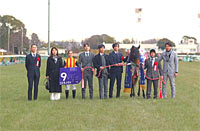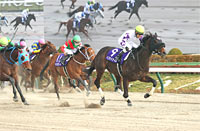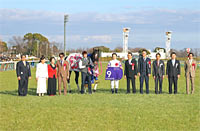February Stakes (G1) - Data Analysis
First JRA G1 race of the year to offer pointers on dirt racing trends in 2020
The 2019 February Stakes winner (Inti) and runner-up (Gold Dream) exhibited strong performance in subsequent races, occupying the Top 2 of the Kashiwa Kinen in May, and finishing in the Top 3 of the Champions Cup in December. Of the 40 Top 2 finishers in the February Stakes since 2000, only four runners achieved their only lifetime Top 2 finish in a JRA G1 or NAR top-level dirt race in the February Stakes: 2004 runner-up Silent Deal, 2009 runner-up Casino Drive, 2012 runner-up Silk Fortune, and 2016 winner Moanin. In other words, this is a race that brings runners together with a strong track record in G1/top-level dirt races and runners that will vie for top positions in major races going forward. Let’s now analyze some features shared by successful runners in this race based on results over the last 10 years.
Focus on runners that were strong performers last time out
Of the 30 Top 3 finishers over the last 10 years, 25 had finished in the “Top 3” of their previous race. Meanwhile, runners that had finished “4th or lower” struggled with a Top 3 ratio of 6.4%. In other words, runners that were strong performers last time out tend to do well in this race. [Table 1]
[Table 1] Performance by finish in previous race (last 10 years)
| Finish in previous race |
Performance
[1st-2nd-3rd-4th or lower] |
Win ratio |
Top 2 ratio |
Top 3 ratio |
| Top 3 |
8-9-8-54 |
10.1% |
21.5% |
31.6% |
| 4th or lower |
2-1-2-73 |
2.6% |
3.8% |
6.4% |
In addition, among runners that had finished “4th or lower” in their previous race, those that had no experience of winning “a 1,600m open-class dirt race held at Tokyo since the previous year” struggled even more with a Top 3 ratio of 3.0%. The last runner in this group to finish in the Top 3 was 2014 winner Copano Rickey. This means we should also lower our expectations of runners coming straight from a major defeat, unless they have a favorable track record in a 1,600m open-class dirt race held at Tokyo, such as the February Stakes. [Table 2]
[Table 2] Among runners that had finished “4th or lower” in their previous race, performance by experience of winning a “1,600m open class dirt race held at Tokyo since the previous year” (last 10 years)
| Win experience |
Performance
[1st-2nd-3rd-4th or lower] |
Win ratio |
Top 2 ratio |
Top 3 ratio |
| Yes |
1-0-2-8 |
9.1% |
9.1% |
27.3% |
| No |
1-1-0-65 |
1.5% |
3.0% |
3.0% |
Expect little from runners that have contested a race below 1,800m last time out
Of the 30 Top 3 finishers in the last 10 years, 23 had contested a “1,800m+” race last time out. Meanwhile, runners that had entered a race “below 1,800m” struggled with a Top 3 ratio of 8.6%. Our primary focus should therefore be on runners that have contested a “1,800m+” race last time out. [Table 3]
[Table 3] Performance by distance of previous race (last 10 years)
| Distance of previous race |
Performance
[1st-2nd-3rd-4th or lower] |
Win ratio |
Top 2 ratio |
Top 3 ratio |
| Below 1,800m |
3-2-2-74 |
3.7% |
6.2% |
8.6% |
| 1,800m+ |
7-8-8-53 |
9.2% |
19.7% |
30.3% |
Furthermore, the seven runners that had contested a race “below 1,800m” last time out and still finished in the Top 3 of the February stakes had all contested the Negishi Stakes in their previous race. [Table 4]
[Table 4] Among runners that had contested a race “below 1,800m” last time out, performance by previous race (last 10 years)
| Previous race |
Performance
[1st-2nd-3rd-4th or lower] |
Win ratio |
Top 2 ratio |
Top 3 ratio |
| Negishi Stakes |
3-2-2-50 |
5.3% |
8.8% |
12.3% |
| Race other than Negishi Stakes |
0-0-0-24 |
0% |
0% |
0% |
In addition, among runners that had contested the “Negishi Stakes” last time out, those that had finished “1st” in that race achieved a strong Top 3 ratio of 50.0%, while those that had finished “4th or lower” were all beaten to 4th or lower in the February Stakes. With the exception of runners that have finished in the Top 3 of the Negishi Stakes, which is as an important prep race, we can expect runners that have contested a “race below 1,800m” last time out to struggle. [Table 5]
[Table 5] Among runners that had contested the “Negishi Stakes” in their previous race, performance by finish in that race (last 10 years)
| Finish in Negishi Stakes |
Performance
[1st-2nd-3rd-4th or lower] |
Win ratio |
Top 2 ratio |
Top 3 ratio |
| 1st |
2-1-1-4 |
25.0% |
37.5% |
50.0% |
| 2nd |
0-1-1-6 |
0% |
12.5% |
25.0% |
| 3rd |
1-0-0-7 |
12.5% |
12.5% |
12.5% |
| 4th or lower |
0-0-0-33 |
0% |
0% |
0% |
Heavier horses perform well
Of the 30 Top 3 finishers in the last 10 years, 23 had contested a “domestic race” last time out and had entered that race at a weight of “500kg or more.” Meanwhile, runners that had weighed in at “below 500kg” struggled somewhat with a Top 3 ratio of 12.3%. In other words, body weight is also a key point to consider. [Table 6]
[Table 6] For runners that had contested a “domestic race” in their last outing, performance by body weight in that race (last 10 years)
Body weight in
previous race |
Performance
[1st-2nd-3rd-4th or lower] |
Win ratio |
Top 2 ratio |
Top 3 ratio |
| Below 500kg |
1-4-2-50 |
1.8% |
8.8% |
12.3% |
| 500kg or more |
9-6-8-75 |
9.2% |
15.3% |
23.5% |
Strong performance by runners that have won a JRA left-handed graded dirt race
Of the 21 Top 3 finishers in the last seven years, 19 (excluding 2014 winner Copano Rickey and 2019 third-place finisher Yuranoto) had experience of winning “a JRA left-handed graded dirt race.” These runners also achieved an excellent Top 3 ratio of 33.9%. This suggests we should check performance in JRA left-handed graded dirt races. [Table 7]
[Table 7] Performance by experience of winning a “JRA left-handed graded dirt race” (last 7 years)
| Win experience |
Performance
[1st-2nd-3rd-4th or lower] |
Win ratio |
Top 2 ratio |
Top 3 ratio |
| Yes |
6-7-6-37 |
10.7% |
23.2% |
33.9% |
| No |
1-0-1-52 |
1.9% |
1.9% |
3.7% |
Shorter careers providing best performances in recent years
Of the 15 Top 3 finishers in the last five years, 12 had “20 or fewer” career starts. Meanwhile, runners that had “21 or more” career starts struggled with a Top 3 ratio of 7.3%. Up to 2014, runners that had “21 or more” career starts commonly delivered strong performance, but if trends in recent years are anything to go by, we should raise our expectations of runners with shorter careers. [Table 8]
[Table 8] Performance by total career starts (last 5 years)
| Total career starts |
Performance
[1st-2nd-3rd-4th or lower] |
Win ratio |
Top 2 ratio |
Top 3 ratio |
| 20 or fewer |
5-4-3-25 |
13.5% |
24.3% |
32.4% |
| 21 or more |
0-1-2-38 |
0% |
2.4% |
7.3% |
Seek out the winner!
Recent winners had all contested a JRA graded race last time out
The last five winners had all contested a JRA graded race last time out. This means we should lower our expectations of runners coming straight from a non-graded, NAR, or overseas race. Other shared features among the five recent winners were that they had experience of winning “a JRA left-handed graded dirt race,” and had 20 or fewer career starts. In other words, we should also keep an eye on the trends outlined in [Table 7] and [Table 8]. [Table 9]
[Table 9] Winners’ previous race, highest finish in “JRA left-handed dirt graded race,” and total career starts (last 5 years)
| Year |
Winner |
Previous race |
Highest finish in
“JRA left-handed dirt graded race” |
Total career starts |
| 2015 |
Copano Rickey |
Tokai Stakes |
1st (2015 Tokai Stakes, etc.) |
15 |
| 2016 |
Moanin |
Negishi Stakes |
1st (2016 Negishi Stakes) |
6 |
| 2017 |
Gold Dream |
Champions Cup |
1st (2016 Unicorn Stakes) |
8 |
| 2018 |
Nonkono Yume |
Negishi Stakes |
1st (2018 Negishi Stakes, etc.) |
20 |
| 2019 |
Inti |
Tokai Stakes |
1st (2019 Tokai Stakes) |
7 |
(Masaya Ibuki)
|



















